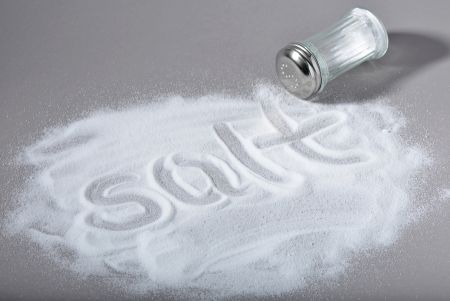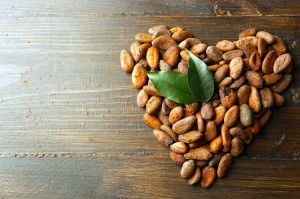

In 2010, approximately 2.3 million people died worldwide due to excessive consumption of salt. This troubling data was introduced at an American Heart Association conference. Ministries of health are coming out with special programs targeted at reducing the amount of salt in food products, and teaching the public how to reduce the amount of salt in cooking and when dining at restaurants.

How much salt do you add to every meal? Most likely too much, and you’re not the only one. Researchers conducting studies worldwide about global salt consumption are talking about a global phenomenon – we’re using double the amount of recommended salt, and it’s ruining our health.
Sodium is the mineral in salt drawing most of the concern. It can be found in the food we consume naturally, and it is vital to maintaining a normal balance of bodily fluids – but not when we’re using too much of it. In 2010, the average daily sodium intake of an average adult was 3,950 mg, approximately double the average of amounts recommended by the World Health Organization (WHO) and other authorities, ranging from 1,500 (United States Dietary Reference Intakes) to 3,000 mg per day (WHO) for an adult, equal to about 5 g regular salt (approximately 1 teaspoon).
According to the United States Institute of Medicine, children aged 1 to 3 years shouldn’t consume over 1,500 mg per day, children from 4 to 8 shouldn’t consume more than 1,900m g salt per day, and children from 9 to 13 shouldn’t consume more than 2,200 mg per day.
It is known that an exaggerated amount of sodium can cause hypertension and cardiologic problems. In 2010 alone, according to worldwide studies conducted by the American Heart Association, 2.3 million people died from heart problems caused by the global overuse of salt.
“This is the first time data collected from around the world was used in one global report on the effects of sodium on the human body,” according to David A. Friedman, a cardiologist with the Long Island health system. Friedman added that the different studies prove that doctors worldwide should warn their patients against overusing salt.
The largest problem lies in salt in processed foods, which is generally more than what the average person would add by sprinkling table salt on fresh foods. It’s estimated that at least 75% of sodium arrives from processed foods, about 10% resides naturally, and about 15% is added to the food during cooking, or while eating, as salt. Unfortunately, eating oversalted foods, while perceived as fun, can alter one’s sense of taste and create a habit of overconsumption of salt that can be very, very difficult to break.
Foods high in sodium
Per 100 g or 3.5 ounces
Salty cheeses – 500-1500 mg
Pickles – 1000-1300 mg
Sauces – 700-1100 mg
Sausages – 600-1000 mg
Salty snacks – 400-1000 mg
Crackers – 400-800 mg
Cereals – 350-600 mg
Prepared salads – 400-550 mg
Bread – 350-500 mg
Too much sodium can cause health problems and complications of existing disorders. Children who suffer from overweight and have excessive sodium intake may experience the development of diseases like hypertension and other health problems, similar to adults’ “metabolic syndrome.”
Global awareness of the damage caused by overusing salt is spreading. For example, events like “World Salt Awareness Week,” promoted by the World Action on Salt and Health, work to encourage everyone “to use a little less salt. (https://tabsnation.com/) ”
Part of the campaign asks chefs – starting in restaurants, followed by catering companies and food carts – to moderate the amounts of salt in their foods, and to promote the use of natural spices and natural components that can add taste while reducing salt.
WHO warns against excessive consumption of salt, addressing both people already suffering from hypertension as well as the entire population, since it is known that consuming large amounts of salt may lead to future problems, even if one’s health is presently normal.
Recently, WHO’s recommendations have been implemented in New York City using billboards in the Manhattan Subway, which warn that “too much salt can cause heart attacks and strokes.” These ads join other warnings against smoking, drinking etc.
Taste is hard to change, so what can I do?
Every nutritional change requires a period of adjustment, and this should be expected when reducing sodium intake. The first stage is to get used to the taste of food without adding salt from the salt shaker. The next stage is to look for foods with lower sodium content. Try to reduce consumption of processed and canned foods which, in most cases, contain large amounts of sodium.
What can you do to reduce your consumption of salt/sodium?
- Gradually reduce sodium consumption – the keyword being gradually. When going cold turkey on the amounts of salt you consume, food might seem bland and tasteless; this can discourage you from continuing. Therefore, it is important to reduce sodium intake gradually to adjust to the new flavors. You should be patient. The process usually takes a few months.
- Compare sodium content between different foods. While shopping for groceries, read food labels and compare different products. Choose products that have a lower amount of sodium like cereals, cheeses, or breads. According to most labeling laws, “low sodium” refers to foods containing no more than 100 mg of sodium per serving. The sodium amounts can be found in the nutritional table.
- As much as possible, try to reduce the consumption of foods containing large amounts of sodium, like sausages, processed and smoked meat and fish products, pickles and olives, snacks, salted cheese, different kinds of crackers, soup and spice powders, salads, prepared spreads and sauces (like soy sauce, mayonnaise, mustard, pesto, and ketchup), prepared meals (like instant noodles/rice and frozen ready-meals), canned meats and fish, and canned vegetables and soups not labeled “low-sodium”.
- During and between meals, eat fresh fruits and vegetables: you can cut them into pieces and serve them as a substitute to salty snacks – cucumber slices, carrot and celery sticks, slices of seasonal fruits, etc. Not only are these low in sodium, but they contain important nutrients that counterbalance sodium in bodily functions.
- When eating, try not to add salt out of habit: try tasting the food first, and if needed, add a smaller amount of salt than what you normally would add. You can also use pepper to add taste instead of salt, or to substitute for a portion of it.
When cooking and preparing meals at home:
- Use fresh and dried herbs while preparing foods. The most popular are basil, thyme, parsley, oregano, dill, and coriander, but there are a myriad others that can take the place of at least some of the salt or soup powders.
- You can and should use a variety of spices and seasoning vegetables like onions, garlic, paprika, turmeric, cumin, a variety of colored peppers and other spices to your taste. They add a lot of color and taste to your food. It is important to use ground spices that don’t contain added salt –it is important to read the ingredient list.
- When making main dishes, you can marinate such things as meat, fish, tofu, and seitan in different herbs and spices and flavoring liquids (such as wine and lemon juice), reducing the need for high-salt seasoning powders and prepared sauces.
- Some main dishes, such as fish do well if you drip lemon juice and sprinkle black or white pepper over them to bring out their flavor.
- Choose homemade sauce over store-bought powdered sauce, which can help you control the amount of salt inside.
- You can roast vegetables in the oven to serve a side dish. The roasting concentrates the vegetables’ taste.
- Instead of salted sauces (mayonnaise, mustard or ketchup) on a sandwich, you can use slices of tomatoes or other vegetables. You can also use smaller amounts of sauce and top the sandwich off with vegetable slices.
- During breakfast or dinner, opt for hot cereal, muesli, or raw granola, which contain smaller amounts of sodium than commercial cereals. You can even make your own using oatmeal, milk and seasonal fruits.
When dining out or ordering in:
- Pizza or pasta: Ask for toppings like tomatoes, onions, or other fresh vegetables instead of olives, anchovies, or cured meats.
- Sandwiches: Ask for added fresh vegetables, and minimize pickles, mustard, or sauerkraut.
- Salad: ask for dressing on the side and not on the salad. Opt for oil and lemon juice/vinegar dressing. This way, you can control your intake of salted dressings and also the consumption of oil found in some of them.
- Main dish: Ask for reduced salt or soy sauce. Carefully read menu descriptions, and ask the waitperson to point out menu items with lower salt.
- Dinner party with friends or family: Ask hosts in advance to cut down on the salt. Remember, salt can always be added later during the meal.
For more great health tips for weight loss and nutrition, click here.
Comments 8
Leave a Reply
You must be logged in to post a comment.




Where do I go from here?
Do I get individual advice about my eating?
I need to be reminded about the 5 foods Not to eat.
Hi, Chris B. You can get individual advice, if you wish – just post your question in one of our Live Forums (you pick which), and I will get back to you.
Regarding the five foods, the video discussed artificial or overprocessed versions of popular foods that should be healthy, but have been manipulated into being particularly harmful to your goals. Rather than giving up on them altogether, we encourage better versions in their original, natural forms. Note that the foods discussed in the video are only examples, and many other popular foods have been similarly affected—so it’s good to read labels, be aware of how a food is made, and choose whole foods as much as possible.
1. Regular “whole wheat” bread—this often also contains refined flours, so it is preferred to select “100% whole” grain products (wheat or other). Even with these products, be sure to read the label and avoid hydrogenated fats or similar ingredients such as mono- and diglycerides.
2. Regular margarine—this is often made from chemically altered fats that create health risks similar to those people are trying to avoid by eating a plant-based product. If you must use a hardened oil, t is better to choose those based on coconut oil, and otherwise to use healthy liquid oils, such as olive, as much as possible.
3. Artificial sweeteners—you can read more about this here: https://www.trimdownclub.com/the-best-way-to-sweeten-your-tea-2.
4. Regular orange juice—If it is in a store, it is likely to have been stripped of what makes it healthy. Even if vitamins etc. have been added back in, it really is not the same. Fresh-squeezed is the way to go.
5. Conventional and overly processed soy—organic is fine, and minimally processed items such as tofu, yogurt, and milk, as well as fermented items such as tempeh and natto are fine. However, most pre-packaged mock meats tend to be a problem.
I think its very critical that you address the need for people to consider switching from traditional table salt, which is very damaging to the body, to a good quality sea salt!! So critical! I’m actually very very surprised you have not addressed this issue in your literature because your program is obviously very well thought out. Now, please know that I recognize that we can certainly overuse sea salt as well. However, there is a vast difference between our traditional table salt and high quality sea salt. I firmly believe that your clients HAVE to be educated as soon as possible about this very important and life saving topic. Thanks, Luxey
I have always drank lots of water and wonder if this will help counter any excessive salt in my diet. Can a person have too little salt?
I have chosen low sugar and low cholesterol on my menu. Do you plan to have an option for low sodium?
It just seems that most things we want to eat or love the taste of is our body’s enemy. Very discouraging having to let go of something that once was so pleasurable.
isn’t pink sea salt better than regular iodized salt and ceyane pepper over black pepper?
Great article and helpful.